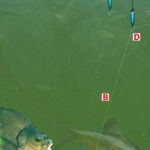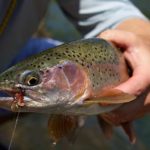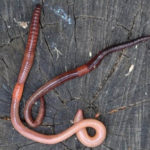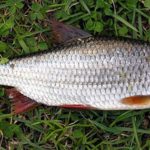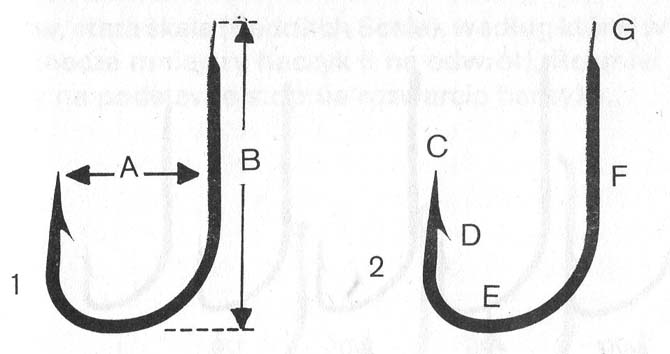 Schemat haczyka
Schemat haczyka
1 :A — rozmiar,
B – długość
2:C – grot (ostrze),
D —zadzior,
E -łuk kolankowy,
F -trzonek,
G – łopatka (lub oczko)
Przedmiotów o groszowej wartości niekiedy nie doceniamy. Jednak gdy mamy do czynienia z haczykami wędkarskimi bądźmy raczej drobiazgowi.
Bez wędziska czy też kołowrotka można by łowić, bez haczyka – w żaden sposób.
Od haczyka bezwzględnie wymagamy dwóch podstawowych cech:
— powinien umożliwiać jak najbardziej delikatne nałożenie przynęty i
— powinien być dostatecznie wytrzymały.
Wymagania te są jednak sprzeczne (delikatnie można nałożyć przynętę tylko na delikatny, cienki haczyk, natomiast delikatność na ogół nie daje się pogodzić z wytrzymałością), z tego też względu optymalnemu ich wyważeniu trzeba poświęcić należytą uwagę. Podstawową rzeczą jest by drut, z którego zrobiono haczyk był najwyższej jakości. Dobrą klasę haczyka warunkuje także technologia produkcji. Haczyk za twardy łamałby się pod obciążeniem, miękki natomiast mógłby się odginać. Bardzo wysokie wymagania stawiamy ostrzu (grotowi) haczyka, a to z tego względu, że siła potrzebna do wbicia ostrza wraz z zadziorem w pysk ryby zwiększa się z grubością materiału w postępie geometrycznym.
Podstawowa zasada uformowania haczyków jest jednakowa. Różnice dotyczą barwy, długości i kształtu trzonka, odchylenia ostrza, wyokrąglenia itd.
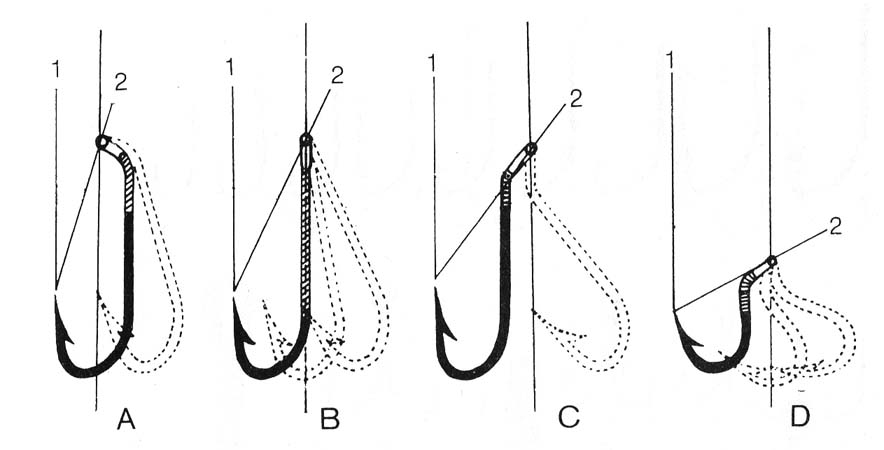 Kąty chwytliwości haczyka
Kąty chwytliwości haczyka
A – najmniejszy kąt chwytliwości (23°)
B – haczyk z oczkiem nie odgiętym (28°)
C – haczyk do wiązania suchej muchy (42°)
D – najgorszy kąt chwytliwości (67°);
1 – opór ryby;
2 — kierunek ruchu ostrza
W haczyku wyróżniamy następujące części: trzonek, który w zależności od metody połowu może być różnej długości, zakończony łopatką, oczkiem lub też ich pozbawiony (te rodzaje są przyklejane do żyłki); rozmaicie ukształtowany łuk kolankowy; ostrze i w większości modeli także zadzior. Wyboru długości trzonka trzeba dokonywać nie tylko ze względu na rodzaj przynęty (np. przy połowach na rosówkę odpowiedniejsze będą trzonki dłuższe, przy połowach na kukurydzę, ziarno itp. – trzonki krótsze), lecz także mając na uwadze chwytliwość haczyka, która jest określona przez wartość tzw. kąta chwytliwości (zwanego też kątem szkodliwym). Mowa o kącie między linią łączącą wierzchołek ostrza z końcem łopatki a linią będącą przedłużeniem ostrza. Wielkość kąta jest zależna od stosunku długości trzonka i rozmiaru łuku, przy czym obowiązuje zasada, że chwytliwość haczyka zwiększa się wraz z wielkością kąta. Przy zacięciu ostrze wbija się w pysk ryby nie prostopadle, lecz pod kątem, który praktycznie jest równy opisanemu kątowi chwytliwości. Na podstawie powyższych informacji można sformułować zasadę, że przy połowie ryb nie wymagających energicznego zacinania można użyć haczyków o dłuższym trzonku, natomiast do połowu ryb o miękkim pysku odpowiednie będą haczyki z krótkim trzonkiem. W pewnym stopniu „łowność” haczyka jest także zależna od jego barwy; tak więc haczyki srebrzyste i złociste można polecać do połowu na jaśniejsze przynęty (larwy, kukurydzę, ziemniaki), a haczyki w ciemniejszych odcieniach stosujemy łowiąc na ciemne przynęty (rosówki itp.)
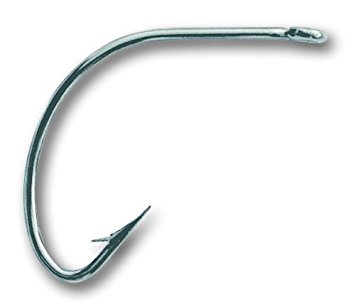 Wyjątkowo bogaty asortyment haczyków – ponad 30 000 rodzajów – umożliwia wybór typu dosłownie na każdą okazję. Z grubsza można dokonać podziału haczyków na trzy podstawowe typy:
Wyjątkowo bogaty asortyment haczyków – ponad 30 000 rodzajów – umożliwia wybór typu dosłownie na każdą okazję. Z grubsza można dokonać podziału haczyków na trzy podstawowe typy:
– okrągłe (round band);
– owalne (limerick);
– graniaste (snack band).
Od tych podstawowych rodzajów został wyprowadzony cały szereg odmian o różnej długości trzonka i uformowaniu łuku, z ostrzem prostym lub odgiętym w bok itd. Pewien problem stanowi numeracja haczyków według wielkości; z wielu klasyfikacji najpowszechniej wykorzystywana jest tzw. stara skala (Redditch Scalę), według której wyższy numer oznacza mniejszy haczyk (i na odwrót). Rozmiar jest określany na podstawie stopnia rozwarcia haczyka.
Najodpowiedniejsze haczyki muchowe mają oczko lub mogą być zakończone łopatką, a czasem pozbawione są zarówno oczka, jak i łopatki. Różnica między haczykami przeznaczonymi do wiązania much mokrych i tymi do wiązania much suchych polega nie tylko na sposobie przegięcia oczka (klasyczne do połowu na suchą muchę mają oczko przegięte do góry, do połowu na mokrą muchę – w dół), lecz głównie na grubości drutu. Haczyki do suchych much powinny być zawsze cienkie i lekkie, by muchy nie tonęły, temu służy również odgięcie do góry oczka. Haczyki do much mokrych i nimf mogą być zrobione z grubszego drutu z oczkiem przegiętym w dół, mają one także najbardziej sprzyjający kąt chwytliwości.


